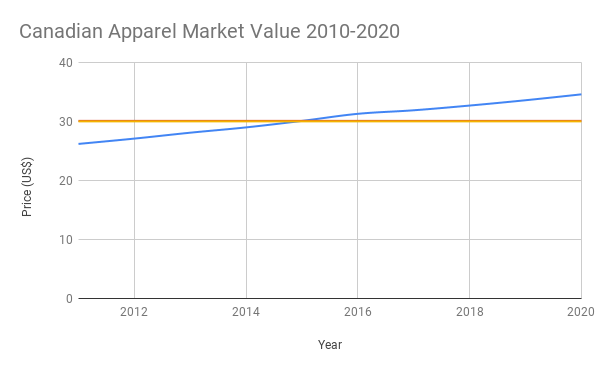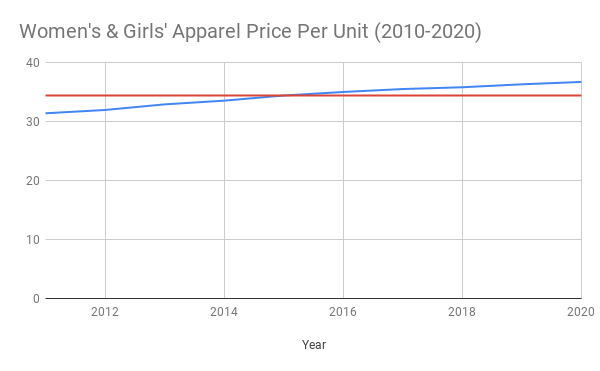Given the economic uncertainty, it must be not an easy time for the fashion industry. However, as recent statistical data and projections keep showing, the Canadian apparel market is set for steady growth. Two important market variables have been studied: market value and price per unit. This paper provides two graphs illustrating Canadian apparel market tendencies and explains them.
Canadian Apparel Market Value

As seen from the graph above (Graph 1), the value of the Canadian apparel market is expected to increase from US$25.6 billion in 2010 to the projected US$34.6 billion in 2020 (the blue line) (“Apparel. Canada,” n.d.). Thus, the statistical data demonstrate a 35% growth over ten years. The orange line is used for both the mean and median values which both roughly equal US$30.1 billion. The first two factors behind this growth tendency are speed and agility as the key characteristics of modern fashion (Cortez, Tu, Van Anh, Ng, & Vegafria, 2014). Many producers do not see creating things that last as sensical anymore. Fashion changes every season if not every week, and the Canadian youth is trying to keep up with its pace by changing their style and buying more clothes. Retail stores have significant discounts around holidays, which also boosts sales. People want to treat themselves and make their friends and family happy, and the price cuts “compensate” part of their expenses.
The second factor explaining the expansion of the Canadian apparel market is the fusion of clothes, media, and entertainment. People no longer buy clothes for warmth, comfort, and convenience. As companies capitalize on brand visions and philosophies, more customers choose to purchase ideas behind an item (Rieke, Fowler, Chang, & Velikova, 2016). For instance, if a brand collaborates with a celebrity, he or she channels their personality into the clothes that they wear. It is only natural that their fans see the style and artistry of their favorite famous person behind a clothing line and relate to it on a different level. On top of that, many people want to “steal” celebrities’ looks.
Women’s and Girls’ Apparel Price per Unit

As seen from the graph above (Graph 2), the price per unit of women’s and girls’ apparel has been on a slow but steady rise from US$30.8 in 2010 to US$38.3 projected for 2020 (the blue line) (“Apparel. Canada,” n.d.). Thus, we can observe a 24% increase over the past ten years. The red line shows both the mean and median values of the prices per unit for the given period — US$34 and US$34.3 respectively. Rising clothes prices are a part of a bigger tendency: researchers have already pointed out that many products in Canada are more expensive than their identical counterparts in the United States. So far, one can point out several reasons that could explain this phenomenon.
Firstly, when an individual purchases in Canada, he or she has to pay both GST (goods/ service tax) and PST (provincial sales tax). When these taxes get stacked on top of each other, they can amount up to a total of 12% depending on the province (Kesselman & Spiro, 2014). Industry Minister James Moore even called the phenomenon of higher retail costs “geographic price discrimination (Milke, 2014).” Another clear explanation is the inflation rate which has been on the low but yet impacted product prices (“Canada inflation rate,” 2019). Lastly, in recent years, clothes have grown to be more than an everyday commodity: they are a means of self-expression and sometimes, a reflection of a person’s status. Many companies do not only sell clothing items — they sell philosophy and ideas for which they charge more than usual.
Conclusion
The modern world is swept by the consumption culture, and as it appears to be, Canada is no exception. Over the last nine years, the Canadian apparel market has been steadily growing and is projected to amount to US$34.6 billion in 2020. A concurrent tendency is rising prices: if in 2010, a piece of women’s clothing cost around $30.8, in 2020, a customer would have to pay as much as $38.3 for the same unit. Frequent shopping and the emotional impact of fashion together with Canadians’ increased purchasing power are what explains the described apparel market tendency. Among other contributing factors is the imperfect system of taxation and the inflation rate.
References
Apparel. Canada.(n.d.). Web.
Canada inflation rate. (2019). Web.
Cortez, M. A., Tu, N. T., Van Anh, D., Ng, B. Z., & Vegafria, E. (2014). Fast fashion quadrangle: An analysis. Academy of Marketing Studies Journal, 18(1), 1-18.
Kesselman, J. R., & Spiro, P. S. (2014). Challenges in shifting Canadian taxation toward consumption. Canadian Tax Journal, 62, 1-47.
Milke, M. (2014). The real reason Canadians pay higher prices than Americans for the same products.HuffPost, Web.
Rieke, S. E., Fowler, D. C., Chang, H. J., & Velikova, N. (2016). Exploration of factors influencing body image satisfaction and purchase intent: Millennial females. Journal of Fashion Marketing and Management, 20(2), 208-229.
Appendix
